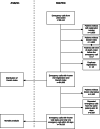Which symptoms pose the highest risk in patients calling for an ambulance? A population-based cohort study from Denmark
- PMID: 33879211
- PMCID: PMC8056716
- DOI: 10.1186/s13049-021-00874-6
Which symptoms pose the highest risk in patients calling for an ambulance? A population-based cohort study from Denmark
Abstract
Background: Emergency medical service patients are a vulnerable population and the risk of mortality is considerable. In Denmark, healthcare professionals receive 112-emergency calls and assess the main reason for calling. The main aim was to investigate which of these reasons, i.e. which symptoms or mechanism of injury, contributed to short-term risk of death. Secondary aim was to study 1-30 day-mortality for each symptom/ injury.
Methods: Historic population-based cohort study of emergency medical service patients calling 112 in the North Denmark Region between 01.01.2016-31.12.2018. We defined 1-day mortality as death on the same or the following day. The frequency of each symptom and cumulative number of deaths on day 1 and 30 together with 1- and 30-day mortality for each symptom/mechanism of injury is presented in proportions. Poisson regression with robust variance estimation was used to estimate incident rates (IR) of mortality with 95% confidence intervals (CI), crude and age and sex adjusted, mortality rates on day 1 per 100,000 person-year in the population.
Results: The five most frequent reasons for calling 112 were "chest pain" (15.9%), "unclear problem" (11.9%), "accidents" (11.2%), "possible stroke" (10.9%), and "breathing difficulties" (8.3%). Four of these contributed to the highest numbers of deaths: "breathing difficulties" (17.2%), "unclear problem" (13.2%), "possible stroke" (8.7%), and "chest pain" (4.7%), all exceeded by "unconscious adult - possible cardiac arrest" (25.3%). Age and sex adjusted IR of mortality per 100,000 person-year was 3.65 (CI 3.01-4.44) for "unconscious adult - possible cardiac arrest" followed by "breathing difficulties" (0.45, CI 0.37-0.54), "unclear problem"(0.30, CI 0.11-0.17), "possible stroke"(0.13, CI 0.11-0.17) and "chest pain"(0.07, CI 0.05-0.09).
Conclusion: In terms of risk of death on the same day and the day after the 112-call, "unconscious adult/possible cardiac arrest" was the most deadly symptom, about eight times more deadly than "breathing difficulties", 12 times more deadly than "unclear problem", 28 times more deadly than "possible stroke", and 52 times more deadly than "chest pain". "Breathing difficulties" and "unclear problem" as presented when calling 112 are among the top three contributing to short term deaths when calling 112, exceeding both stroke symptoms and chest pain.
Keywords: Diagnosis; Emergency medical services; Emergency medicine; Mortality; Risk.
Conflict of interest statement
The authors declare that they have no competing interests.
Figures



Similar articles
-
Symptom, diagnosis and mortality among respiratory emergency medical service patients.PLoS One. 2019 Feb 28;14(2):e0213145. doi: 10.1371/journal.pone.0213145. eCollection 2019. PLoS One. 2019. PMID: 30817792 Free PMC article.
-
Trends in diagnostic patterns and mortality in emergency ambulance service patients in 2007-2014: a population-based cohort study from the North Denmark Region.BMJ Open. 2017 Aug 21;7(8):e014508. doi: 10.1136/bmjopen-2016-014508. BMJ Open. 2017. PMID: 28827233 Free PMC article.
-
Diagnoses and mortality among prehospital emergency patients calling 112 with unclear problems: a population-based cohort study from Denmark.Scand J Trauma Resusc Emerg Med. 2022 Dec 12;30(1):70. doi: 10.1186/s13049-022-01052-y. Scand J Trauma Resusc Emerg Med. 2022. PMID: 36503609 Free PMC article.
-
Diagnosis and mortality in prehospital emergency patients transported to hospital: a population-based and registry-based cohort study.BMJ Open. 2016 Jul 4;6(7):e011558. doi: 10.1136/bmjopen-2016-011558. BMJ Open. 2016. PMID: 27377636 Free PMC article.
-
High-sensitivity troponin assays for early rule-out of acute myocardial infarction in people with acute chest pain: a systematic review and economic evaluation.Health Technol Assess. 2021 May;25(33):1-276. doi: 10.3310/hta25330. Health Technol Assess. 2021. PMID: 34061019 Free PMC article.
Cited by
-
TeLePhone Respiratory (TeLePoR) score to assess the risk of immediate respiratory support through phone call for acute dyspnoea: a prospective cohort study.Scand J Trauma Resusc Emerg Med. 2025 May 16;33(1):88. doi: 10.1186/s13049-025-01405-3. Scand J Trauma Resusc Emerg Med. 2025. PMID: 40380197 Free PMC article.
-
Determining the research priorities for emergency care within the Western Cape province of South Africa: A consensus study.Afr J Emerg Med. 2024 Mar;14(1):1-6. doi: 10.1016/j.afjem.2023.11.007. Epub 2023 Dec 3. Afr J Emerg Med. 2024. PMID: 38077252 Free PMC article.
-
A novel interpretable deep learning model for diagnosis in emergency department dyspnoea patients based on complete data from an entire health care system.PLoS One. 2024 Dec 27;19(12):e0311081. doi: 10.1371/journal.pone.0311081. eCollection 2024. PLoS One. 2024. PMID: 39729465 Free PMC article.
-
2021 Guideline for the Management of COPD Exacerbations: Emergency Medicine Association of Turkey (EMAT) / Turkish Thoracic Society (TTS) Clinical Practice Guideline Task Force.Turk J Emerg Med. 2021 Oct 29;21(4):137-176. doi: 10.4103/2452-2473.329630. eCollection 2021 Oct-Dec. Turk J Emerg Med. 2021. PMID: 34849428 Free PMC article.
-
The development of a decision support tool in the prehospital setting for acute chest pain - a study protocol for an observational study (BRIAN2).Scand J Trauma Resusc Emerg Med. 2025 Jan 6;33(1):4. doi: 10.1186/s13049-024-01314-x. Scand J Trauma Resusc Emerg Med. 2025. PMID: 39762958 Free PMC article.
References
-
- Christensen EF, Bendtsen MD, Larsen TM, Jensen FB, Lindskou TA, Holdgaard HO, et al. Trends in diagnostic patterns and mortality in emergency ambulance service patients in 2007–2014: a population-based cohort study from the North Denmark Region. BMJ Open. 2017;7(8):e014508. doi: 10.1136/bmjopen-2016-014508. - DOI - PMC - PubMed
-
- Dinh MM, Muecke S, Berendsen Russell S, Chalkley D, Bein KJ, Muscatello D, et al. Demand for emergency services trends in New South Wales years 2010–2014 (DESTINY): age and clinical factors associated with ambulance transportation to emergency departments. Prehosp Emerg Care. 2016;20(6):776–82. 10.1080/10903127.2016.1182603. - PubMed
Publication types
MeSH terms
LinkOut - more resources
Full Text Sources
Other Literature Sources
Medical
Miscellaneous

